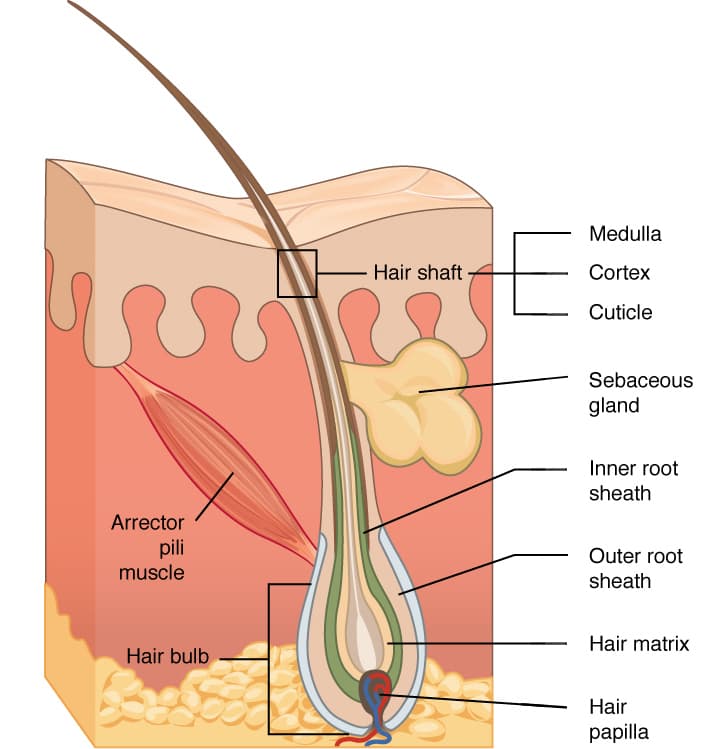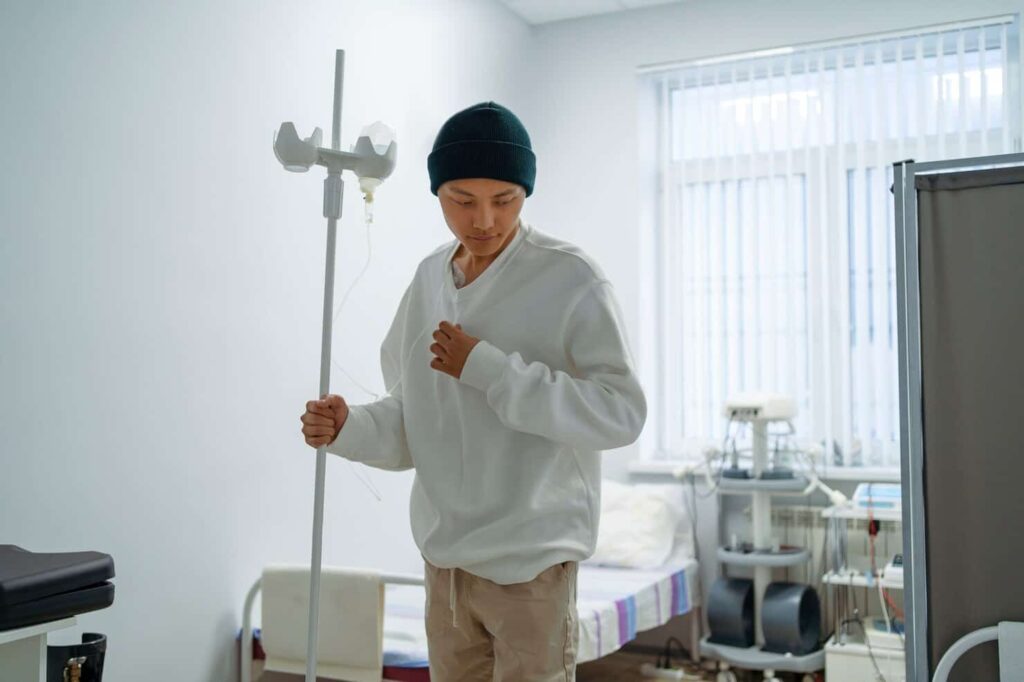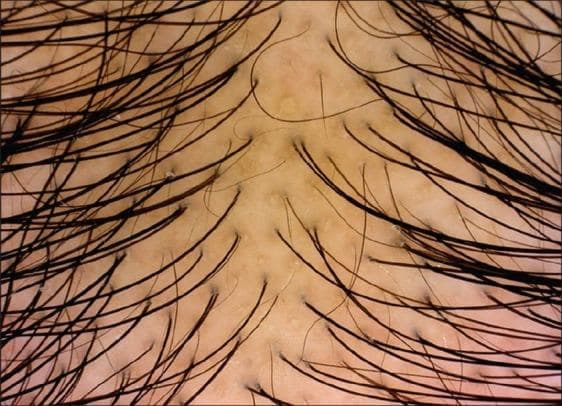Anagen effluvium is a non-scarring alopecia in which hair growth is abnormally interrupted during the anagen (growth) phase.
It’s also known as chemotherapy-induced hair loss because chemotherapy drugs are the most common cause of this type of hair loss.
Even though anagen effluvium isn’t uncommon, many people don’t know what it is or what triggers it. Unfortunately, there’s no effective treatment for it either.
However, some things may help you prevent or regrow your hair if it’s been affected by anagen effluvium.
What Is Anagen Effluvium?
In anagen effluvium, hair breaks rather than sheds. And the intensity of hair loss varies depending on the actual trigger, its dosage and the duration of exposure.
This kind of hair loss doesn’t progress in a distinct pattern. In fact, it can strike quite suddenly and cause diffuse or patchy alopecia.
Additionally, anagen effluvium can affect all the hair-bearing areas on the body, including the eyebrows, eyelashes, moustache, beard, armpit and pubic hair.
Still, it’s the most noticeable on the scalp because that’s where the majority of the hair (~90%) is normally in the anagen phase.

Anagen effluvium occurs due to an injury (from a drug, toxin or inflammation) to the hair bulb. This bulb contains the hair matrix, which has the cells to form the shaft of growing hair.
In the event of an injury, the cells in the hair bulb matrix stop undergoing what’s known as “mitosis.” Mitosis is the process by which cells divide and duplicate to allow the hair to grow and develop.
However, once that stops, the hair shaft is narrowed, weakened and damaged. As a result, it breaks and falls off. On being pulled, you can see the dystrophic hair (misshapen bulb and no root sheath) with a pencil-pointed end.
This effluvium can happen 1-3 weeks after the injury. And it will affect the hair in the active anagen phase.
Anagen effluvium can affect anyone at any age, and it affects both men and women equally.
What Causes Anagen Effluvium?
Any of the following factors can disrupt cell division in the hair matrix.
Chemotherapy
As mentioned above, chemotherapy is the most common cause of anagen effluvium. Research published in Current Oncology reports that 65% of the patients receiving chemotherapy experience hair loss.

Chemotherapy treatment contains drugs that inhibit cell division (mitosis) and interfere with the metabolic activity of the cells in the hair. The alkylating agents in it damage the DNA of the cells, which stops them from making copies of themselves. All this can cause anagen effluvium.
Chemo drugs that are known to cause this include:
- Doxorubicin
- Bleomycin
- Cyclophosphamide
- Methotrexate
- Nitrosoureas
- Fluorouracil
- Daunorubicin
- Dactinomycin
Keep in mind that the severity of hair loss can vary depending on the drugs, their dosage, and the duration of treatment.
Hair loss usually begins two weeks after chemotherapy begins, and patients can lose all their hair within two to three months.
While this hair loss is usually temporary, sometimes, it can be permanent.
Radiotherapy
Radiotherapy to the head can also cause anagen effluvium in the treatment area.
However, with radiation therapy, hair follicle stem cells can also be affected along with the cells in the hair bulb matrix.
As a result, you might experience permanent hair loss (not always, though). According to the author of the book “The Alopecias,” this usually happens when the total physical dose is more than 50 Gy of soft X-rays and 30 Gy of deep X-rays.
Unfortunately, radiotherapy can also cause scarring alopecia.
Medication
The intake of certain medications can also cause anagen effluvium.
These include:
- Levodopa – commonly prescribed for Parkinson’s
- Cyclosporine – to prevent organ transplant rejection
- Colchicine – for gout and Behcet’s disease
- Albendazole – for worm infections
- Isoniazid – for tuberculosis
- Strontium ranelate – for severe osteoporosis
Anagen effluvium from medications will likely reverse once the drug is discontinued.
Toxic Heavy Metals
Intoxication from heavy metals can also cause anagen effluvium.
According to different research and case studies, toxic exposure to the following metals can cause this type of hair loss:
- Bismuth
- Arsenic
- Thallium
- Cadmium
- Copper
- Lead
- Boron
- Mercury
Hair regrowth may be possible in this case too. However, you need to get treatment first.
Health Problems
Certain illnesses can also interrupt the anagen phase of hair growth.
For instance, inflammation from alopecia areata can cause dystrophic anagen.
Autoimmune diseases like lupus and pemphigus vulgaris can also do the same.
Additionally, anagen effluvium has been reported in infectious diseases like syphilis and COVID.
This kind of hair loss is also likely to be reversible.
Protein-Energy Undernutrition (PEU)
Protein-energy undernutrition, also known as protein-energy malnutrition, is a condition that results from a deficiency of dietary protein. This can also lead to anagen effluvium.
How Long Does Anagen Effluvium Last?
The effects of anagen effluvium can last for as long as the causative agent(s) are present. Hair loss can start just days to weeks after exposure.
And it can last for a couple of months or even longer. Eventually, you might have no hair left. However, this hair loss can stop once the underlying problem is treated.
Is Anagen Effluvium Reversible?
In most cases, anagen effluvium is reversible. That’s because this condition spares the hair follicle stem cells, so your hair can start to regrow just after a few weeks. It might become more noticeable to you after 1-3 months.
Some people, however, regrow their hair with different a texture, colour, and thickness. For instance, if you had wavy or curly hair, it might grow out straight. Or it can also change colour and become grey. Keep in mind that these hair changes can be permanent.
Unfortunately, in some cases, anagen effluvium can lead to permanent hair loss as can happen in radio or chemotherapy.
How Is Anagen Effluvium Diagnosed?
To diagnose anagen effluvium, your doctor will probably ask questions about your medical history, health, general life, and diet. They will also perform a physical exam.
Other than that, a hair pull test and some blood tests might also be done to get an accurate diagnosis. A scalp dermoscopy may also be done to rule out other similarly presenting alopecias.

A biopsy will probably not be needed, but it may be taken as well. These biopsies can show the ratio of anagen to telogen (resting stage) hair (which comes out to be normal if it’s anagen effluvium).
How Do You Fix Anagen Effluvium?
As of now, there is no effective treatment for anagen effluvium, according to research. In general, patients are prescribed minoxidil because it helps with hair growth.
One study published in the Journal of the American Academy of Dermatology found that 2% minoxidil for chemotherapy-induced alopecia shortened the period of baldness by almost 50 days.
To stop hair loss in the first place, it’s important to seek the advice of a medical professional. The good news is that this hair loss is usually reversible, so your hair will start to grow back.
Although if you’ve experienced permanent hair loss, you may be a suitable candidate for hair transplantation.
What Is The Difference Between Anagen Effluvium And Telogen Effluvium?
The key difference between anagen and telogen effluvium is the phase of hair growth in which shedding occurs.
In anagen effluvium, hair fractures while it’s still in the active anagen phase. However, in telogen effluvium, the hair shifts abnormally from the growing (anagen) phase to the resting (telogen) phase.
Anagen effluvium can cause sudden hair loss. While in the case of telogen effluvium, hair loss occurs 3-4 months after the stressful event.
However, keep in mind that it is possible for you to experience hair loss due to both simultaneously.
Here’s a summary of the differences between the two types of hair loss:
| Anagen Effluvium | Telogen Effluvium | |
| Causes | Chemotherapy, radiotherapy, medication, toxic heavy metals, health problems, and protein deficiency | Physical and emotional stressors, such as surgery, malnutrition, illness, childbirth, drugs, stress, diet, hormonal imbalance, etc. |
| Hair Appearance | Pencil-point | Club-shaped |
| Duration of Hair Loss | Until the hair follicle is affected by the causative agents | 3-6 months (unless chronic) |
| Start of Hair Loss | Days to weeks after the injury | 3-4 months after the stressful event |
| Hair regrowth | Weeks after the underlying problem is solved | After 3-6 months |
| Reversibility | Usually completely reversible, but accompanying hair changes can be permanent Rarely permanent | Temporary and reversible |
| Treatment | None | None required |
How Do You Prevent Anagen Effluvium?
It’s not possible to prevent anagen effluvium in all instances. However, there are certain devices that may help in some situations. These are as follows:
- Scalp Tourniquet – It’s an inflatable hairband that goes around the scalp and aims to reduce the blood flow to the scalp. Again, the idea is that chemo drugs won’t reach the follicles.
Cooling Caps – The purpose of these caps is to induce scalp hypothermia by cooling it down to less than 24°C. This reduces blood flow to the scalp and hence the amount of chemo drugs reaching the scalp.

These devices have certain downsides. For instance, it’s feared that if you’re wearing devices, it may not get rid of cancer in the scalp area.
What you can do is make sure that you’re practising very gentle hair care. This should mean avoiding the use of styling tools or chemical dyes. Your shampoo should also have a mild formula, and you shouldn’t brush your hair too hard.
One of the ways in which many people cope with this kind of hair loss is camouflage. You can consider wearing scarves, caps, bandanas, hairpieces, etc.
Conclusion
Anagen effluvium is not often talked about. There’s not a lot of research on it either. But it is something that affects many people, especially those who’re receiving chemo or radiotherapy.
Fortunately, this type of hair loss is usually reversible. However, it’s important to get treatment for the root cause of the problem (again, it’s not always possible).
If you’re also experiencing sudden hair loss, make sure to get in touch with a board-certified medical professional as soon as possible.
Reviewed and Approved by Trichologist Yaprak Yazan


